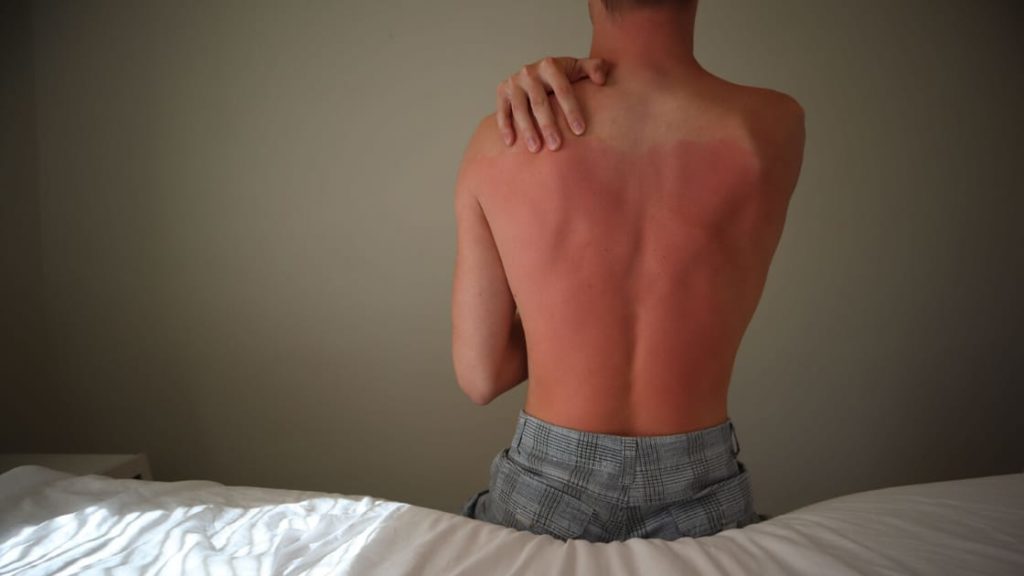Taking Sunburn Seriously

Summer is creeping up on us, and you know what that means! Increased risk of sunburn is creeping up on us too!
Two of my recent articles already touched base on the awesomeness of the sun. It enhances your mood, provides vitamin D3, and is much more pleasant than ice storms and windchill. But, as is common knowledge, the sun can be a jerk sometimes too. And a big jerk at that, being more than a hundred times bigger than our earth.
What to Do If You Get a Sunburn
So, let’s say you burned yourself. It happens. You spent more time outside than you planned to, you forgot your sunblock, you couldn’t find a shaded area, all that stuff. I’m sorry this happened to you, and I wish you a speedy recovery! And on that note, let’s talk about how to make this recovery a smooth one. Here’s what to do!
Don’t Pull Your Skin
As tempting as it may be, there is no need to peel your skin. Your body will shed its reptilian coat on its own, and it’s part of the natural healing process. Don’t pull, don’t exfoliate, don’t scrub! You’ll just cause the skin to become more inflamed, prolonging the pain and slowing recovery. Mild to moderate sunburn should stop peeling after one week, so be patient.
Use Anti-inflammatory Creams
Aloe vera, cortisone, and aspirin are some common go-to’s for sunburn relief. Vitamin C essential oil is worth a shot too, as it boosts wound healing and enhances your ability to fight infection.
Moisturize After Bathing
If you moisturize while your skin is damp, the moisture will seal in more effectively.
Avoid Petroleum-Based Creams
Petroleum jelly and other oil-based products clog pores, which will prevent heat and sweat from escaping. The trapped heat won’t only make peeling worse, it can also lead to infection.
Use Cold Therapy
Ice compresses and cold showers are your skin’s friends. You might want to consider freezing your aloe before applying it to a burn — enhance the anti-inflammatory effects of both!
Hydrate
Sunburn does more than just redden, flake, and ache. It also draws fluid up to the skin’s surface, taking it away from your body. Make sure to replace the lost fluids and electrolytes by drinking lots of water.
Cover Burned Area
When venturing back outside, the last thing you want to do is turn a mild-moderate sunburn into a severe sunburn. Have you ever seen third degree sunburns? Don’t google an image if you’re eating.
Make sure every affected area is covered, ideally with loose-fitting material. Drape a towel over your neck, wear long sleeves, whatever you have to do to keep that sun from seeing the damage it’s done!
Why Take a Sunburn Seriously
While the symptoms of sunburn are only temporary, the skin cell damage can be permanent and have lasting effects. Excessive exposure to UV radiation damages the skin and increases risk of skin cancers, including malignant melanoma.
While skin cancer has a high survival rate — close to 99% when detected early — the warning signs can be easy to miss. They’re easy to miss because the most well known symptom is the change in a mole. Moles aren’t only extremely common, but they can be numerous and tend to grow on our backs. Unless you have a full length mirror and a flexible neck, chances are you don’t get a regular good look at every mole on your back.
Have you ever heard of ABCDE rule? It’s a guide for the usual symptoms of skin cancer. Each letter stands for a change in a mole. Get to know your skin, and watch for any of the following changes.
- Asymmetry: Moles are usually circular and fairly symmetrical. If one half of a mole is larger than the other, it may be cause for concern.
- Border: The outline of a mole is usually smooth. An abnormal mole might have a jagged border.
- Color: A single mole is usually the same color throughout, usually brownish. Do you see splotches of a different color in a mole? If a mole changes color, it could be a sign of melanoma.
- Diameter: While some of us are born with large moles, (larger than a pea is considered large), a new large mole should be examined by a doctor.
- Evolving: Did your mole suddenly become asymmetrical, jagged, discolored, large? Is it continuing to do any of those things? Get it checked out.
Now you know what to do and why you need to do it! Be safe, be healthy, and have comfortable skin! Happy summer!
Katrina Jenkins
Author, Licensed Massage Therapist
Katrina Jenkins graduated from Towson University in 2013 with a Bachelor’s Degree in Health Science and worked as a nurse’s aide briefly before pursuing her true passion. She graduated from the Massage Therapy Institute of Colorado in April 2016 with honors and completed the Touch of Healers Scholarship Program the following summer. She has been a part of the Moyer Total Wellness Team since the summer of 2017.
Resources
Huizen, Jennifer. “8 Essential Oils for Sunburn.” Www.medicalnewstoday.com, 19 Oct. 2017, www.medicalnewstoday.com/articles/319745.
“Signs of Melanoma Skin Cancer | Symptoms of Melanoma.” Www.cancer.org, www.cancer.org/cancer/melanoma-skin-cancer/detection-diagnosis-staging/signs-and-symptoms.html#:~:text=Spread%20of%20pigment%20from%20the.
“Sunburn: MedlinePlus Medical Encyclopedia.” Medlineplus.gov, medlineplus.gov/ency/article/003227.htm#:~:text=If%20your%20skin%20is%20not.
Photo Credit
Canva
